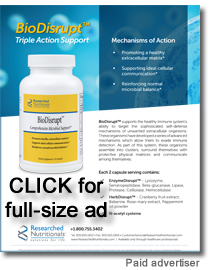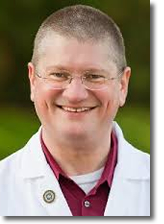|

|
|
Metabolic Therapies in Advanced "Salvage" Cancer Cases
by Dr. Paul S. Anderson, NMD
 |
|
|
|
|
Page 1, 2
Combined Metabolic Oncology Therapy
| Protocol Overview: |
1. Dietary Intervention
2. Use of supplemental retinol
3. Use of intravenous Poly-MVA and DCA
4. Addition of hyperbaric oxygen therapy (HBOT) |
Specific Protocol:
|
| 1. Dietary Intervention: |
| |
- Patients are on a ketogenic or (at least) low carbohydrate diet.
|
| |
|
- When calculating carbohydrates use ONLY the "net carbohydrate" values (Net carbohydrate is [Total Carbohydrate – Fiber]). Ultimate ketone goal in blood is over 3.0 millimolar.
- In either diet the patient needs to consume high-fiber vegetables.
- Most juices and smoothies have too much sugar and cannot be used.
|
| |
- Oral ketone supplements starting at 2.5 grams BID and increasing to 5 grams BID as tolerated. [35 – 70 mg/Kg pediatric dose BID]
- Daily intermittent fasting should be followed with the last meal ending at 7:00 PM and the first meal at 8:00 AM or after.
- If patients are losing weight/cachexic, have them consume 10-20 mL of MCT [1-5 mL pediatric] oil every 1 to 2 hours. They may need bile salts as support. Then look at their caloric macronutrient levels and adjust the fat up and potentially some increase in protein.
- Note that too much protein will trigger glucogenic amino acid conversion and so this should be avoided.
|
2. Retinol Rx: Patients are given vitamin A: 25,000 IU Retinol [350 IU/Kg pediatric] in a fat soluble (not carotenoid) form orally once daily. If patient has AST/ALT over 300, decrease to 5000 IU daily.
3. Administration of Poly-MVA and DCA intravenously as outlined below. The Poly-MVA IV is always first then the DCA IV follows directly after the Poly-MVA.
The first IV is a test dose: |
| |
- Poly-MVA 10 mL in 500 mL Normal Saline [0.1 mL/Kg for pediatric – in 100 mL NS] and then DCA 10 mg/kG in 500 mL Normal Saline [100 -250 mL in pediatric]
- Note: For both above, you may substitute 0.45 saline in dehydrated patients.
|
| The following IV's are at full dose: |
| |
- Poly-MVA 25 mL in 500 mL Normal Saline [0.5 mL/Kg for pediatric – in 100 mL NS] and then DCA 20 mg/kG in 500 mL Normal Saline [100-250 mL pediatric]
- Note: For both above, you may substitute 0.45 saline in dehydrated patients.
- In aggressive cases, doses of Poly-MVA may be titrated up to 40 mL [0.5 mL/Kg] and DCA may be titrated up to 30-40 mg/Kg – if tolerated.
|
| 4. Use of concurrent HBOT: |
| |
- We begin with a 1.3 to 1.5 ATA trial, bottom time 60 minutes with O2 by mask. Dive may be increased to 1.5 ATA X 60 minutes. At higher ATA air breaks are required: Once at depth use O2 by mask for 15 minutes then 10 minutes air break then 15 minutes O2 by mask.
- SCHEDULE: Minutes 1-15 with mask; Minutes 15-25 without mask; minutes 25 to 40 with mask minutes 40 to 50 without mask and minutes 50-60 with mask.
- With the full protocol above, two HBOT dives per week are optimal.
|
| 5. Lab testing: |
| |
- Baseline standard labs including chemistries with eGFR and ALT, AST and CBC. Other labs as indicated for the patient.
- Draw all follow up eGFR and liver functions on Sunday or Monday AM before any IV's are done. If not, the renal functions can be falsely altered.
|
| 6. Duration and frequency of therapy: |
| |
- In the case series mentioned above and patients since, we have noted a variety of response patterns and a variety of treatment duration requirements.
- Frequency of treatment:
|
| |
|
- If using the IV protocol, we administer the Poly-DCA twice to three times weekly.
- If using the oral protocol, we have the patient administer the Poly-DCA four days weekly.
- Supplements and diet changes are daily, unless noted above.
|
| |
|
| |
|
 - The first re-assessment is normally completed at eight weeks unless there is an objective test (PET etc.) within 12 weeks and then it is extended to 12 weeks.
- Assessment includes any disease specific markers, physical exam, general and quality of life symptoms, non-specific markers (e.g. HsCRP), imaging if indicated and any patient specific finding or marker indicated.
- Re-assessment includes any pertinent positive findings in the above list.
- If therapy is improving quality-of-life measures and/or any of the above clinical markers, we recommend continuing in one of the following ways:
|
| |
|
» If disease is stable and clinical indicators dictate, a maintenance schedule is designed. This is typically two to three days weekly oral Poly-DCA protocol with all supplements and diet changes continuing daily.
» If improvements are positive but the underlying disease is aggressive, we will recommend continuing the primary therapy schedule above and re-assessing in 8-12 weeks.
|
| |
- Continued dietary alterations:
|
| |
|
- As the dietary alterations were key to success in the original case series of patient response, we advise patients to continue the diet changes long term.
- Same recommendation for the supplements.
|
Page 1, 2
References .pdf
 Paul S. Anderson, NMD, is medical director of Advanced Medical Therapies in Seattle, Washington, a clinic focusing on the care of patients with cancer and chronic diseases. Former positions include professor of pharmacology and clinical medicine at Bastyr University and Chief of IV Services for Bastyr Oncology Research Center. He is a graduate of National College of Natural Medicine (Portland, Oregon) and began instructing classes at naturopathic medical schools in the early 1990s. He is co-author of the Hay House book Outside the Box Cancer Therapies with Dr. Mark Stengler as well as a co-author with Jack Canfield in the anthology Success Breakthroughs. He is a frequent CME speaker and writer and has extended his educational outreach through his CE website www.ConsultDrAnderson.com. Paul S. Anderson, NMD, is medical director of Advanced Medical Therapies in Seattle, Washington, a clinic focusing on the care of patients with cancer and chronic diseases. Former positions include professor of pharmacology and clinical medicine at Bastyr University and Chief of IV Services for Bastyr Oncology Research Center. He is a graduate of National College of Natural Medicine (Portland, Oregon) and began instructing classes at naturopathic medical schools in the early 1990s. He is co-author of the Hay House book Outside the Box Cancer Therapies with Dr. Mark Stengler as well as a co-author with Jack Canfield in the anthology Success Breakthroughs. He is a frequent CME speaker and writer and has extended his educational outreach through his CE website www.ConsultDrAnderson.com.
|

Consult your doctor before using any of the
treatments found within this site.

Subscriptions
are available for
Townsend Letter, the Examiner of Alternative Medicine
magazine, which is
published 10 times each year. Search our pre-2001
archives for further information. Older issues of the printed magazine
are also indexed for your convenience.
1983-2001
indices ; recent indices. Once you find the magazines you'd like to order, please
use our
convenient form, e-mail subscriptions@townsendletter.com,
or call 360.385.6021.
360.385.6021
Fax: 360.385.0699
info@townsendletter.com
Who are
we? | New articles | Featured
topics | e-Edition |
Tables of contents | Subscriptions | Contact
us | Links | Classifieds | Advertise |
Alternative
Medicine Conference Calendar | Search site | Archives |
EDTA Chelation Therapy | Home
© 1983-2018 Townsend Letter
All rights reserved.
Website by Sandy
Hershelman Designs |

|
![]()
![]()
![]()
![]()







 Paul S. Anderson, NMD, is medical director of Advanced Medical Therapies in Seattle, Washington, a clinic focusing on the care of patients with cancer and chronic diseases. Former positions include professor of pharmacology and clinical medicine at Bastyr University and Chief of IV Services for Bastyr Oncology Research Center. He is a graduate of National College of Natural Medicine (Portland, Oregon) and began instructing classes at naturopathic medical schools in the early 1990s. He is co-author of the Hay House book
Paul S. Anderson, NMD, is medical director of Advanced Medical Therapies in Seattle, Washington, a clinic focusing on the care of patients with cancer and chronic diseases. Former positions include professor of pharmacology and clinical medicine at Bastyr University and Chief of IV Services for Bastyr Oncology Research Center. He is a graduate of National College of Natural Medicine (Portland, Oregon) and began instructing classes at naturopathic medical schools in the early 1990s. He is co-author of the Hay House book